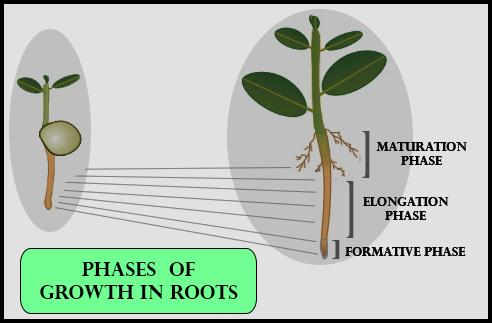
What are the different phases of growth in plants? Give characteristics of each.
Answer
477.3k+ views
Hint: They are the different stages of plant growth showing the continuous growth of the plant from seed germination to the complete plant.
Complete answer:
Growth is the most fundamental characteristic of all living organisms. It is an irreversible and permanent metabolic process. Plants have a unique ability to continue throughout their life cycle. This entire process is carried out by the specialized cells called meristems.
Phases of growth in plants
There are three phases of growth in plants.
Meristematic (Formative phase) – This phase consists of continually dividing cells called meristematic cells at the root apex and shooting apex. The cells in this region have large nuclei and rich protoplasm. The cell walls of these cells are primary, thin cellulose with abundant plasmodesmata connections.
Elongation (Cell enlargement phase) – The cells of elongation are present just after the meristematic region. The cells of this region have increased vacuolation, cell enlargement, and new cell wall deposition. Cell enlargement may be linear or in all directions.
Maturation phase – These cells are present just below the phase me of elongation, but away from the apex where the phase of maturation is found. The cells in this region reach their maximal size with cell wall thickening and new protoplasm formation. They form various simple and complex tissues of plants to perform different functions.

Note: Various plant tissues are developed due to the occurrence of three processes, they are: Differentiation (when the cells stopped dividing and are beginning to mature and perform special functions), Dedifferentiation (when the differentiated cells lost their ability to divide and then regain the capacity to divide), and Redifferentiation (dedifferentiated cells divide and once again produce cells that can no longer divide but mature to perform special functions).
Complete answer:
Growth is the most fundamental characteristic of all living organisms. It is an irreversible and permanent metabolic process. Plants have a unique ability to continue throughout their life cycle. This entire process is carried out by the specialized cells called meristems.
Phases of growth in plants
There are three phases of growth in plants.
Meristematic (Formative phase) – This phase consists of continually dividing cells called meristematic cells at the root apex and shooting apex. The cells in this region have large nuclei and rich protoplasm. The cell walls of these cells are primary, thin cellulose with abundant plasmodesmata connections.
Elongation (Cell enlargement phase) – The cells of elongation are present just after the meristematic region. The cells of this region have increased vacuolation, cell enlargement, and new cell wall deposition. Cell enlargement may be linear or in all directions.
Maturation phase – These cells are present just below the phase me of elongation, but away from the apex where the phase of maturation is found. The cells in this region reach their maximal size with cell wall thickening and new protoplasm formation. They form various simple and complex tissues of plants to perform different functions.

Note: Various plant tissues are developed due to the occurrence of three processes, they are: Differentiation (when the cells stopped dividing and are beginning to mature and perform special functions), Dedifferentiation (when the differentiated cells lost their ability to divide and then regain the capacity to divide), and Redifferentiation (dedifferentiated cells divide and once again produce cells that can no longer divide but mature to perform special functions).
Recently Updated Pages
Can anyone list 10 advantages and disadvantages of friction

What are the Components of Financial System?

How do you arrange NH4 + BF3 H2O C2H2 in increasing class 11 chemistry CBSE

Is H mCT and q mCT the same thing If so which is more class 11 chemistry CBSE

What are the possible quantum number for the last outermost class 11 chemistry CBSE

Is C2 paramagnetic or diamagnetic class 11 chemistry CBSE

Trending doubts
10 examples of friction in our daily life

The correct order of melting point of 14th group elements class 11 chemistry CBSE

Difference Between Prokaryotic Cells and Eukaryotic Cells

One Metric ton is equal to kg A 10000 B 1000 C 100 class 11 physics CBSE

What is the specific heat capacity of ice water and class 11 physics CBSE

State and prove Bernoullis theorem class 11 physics CBSE




